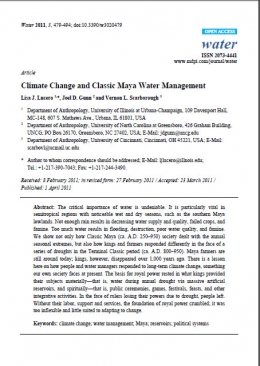Climate Change and Classic Maya Water Management
Year:
2011
Publisher:
Water 2011, 3, 479-494
The critical importance of water is undeniable. It is particularly vital in semitropical regions with noticeable wet and dry seasons, such as the southern Maya lowlands. Not enough rain results in decreasing water supply and quality, failed crops, and famine. Too much water results in flooding, destruction, poor water quality, and famine. We show not only how Classic Maya (ca. A.D. 250–950) society dealt with the annual seasonal extremes, but also how kings and farmers responded differently in the face of a series of droughts in the Terminal Classic period (ca. A.D. 800–950). Maya farmers are still around today; kings, however, disappeared over 1,000 years ago. There is a lesson here on how people and water managers responded to long-term climate change, something our own society faces at present. The basis for royal power rested in what kings provided their subjects materially—that is, water during annual drought via massive artificial reservoirs, and spiritually—that is, public ceremonies, games, festivals, feasts, and other integrative activities. In the face of rulers losing their powers due to drought, people left. Without their labor, support and services, the foundation of royal power crumbled; it was too inflexible and little suited to adapting to change.
ISBN:
doi:10.3390/w3020479
ISSN:
2073-4441
Work regions:
Publication Type:
Publication language:
English

Files:
